롤란드 파르카스 Roland FARKAS
 Roland FARKAS was born as a member of the Hungarian community in the closed society of the former socialist Czechoslovakia. He has experienced the transition from a communist society to a capitalist one in his early teens. After years of musical experimentation in different punk rock bands FARKAS’s interest gradually shifted towards visual arts. The artist moved to Budapest, Hungary ten years ago where he recently lives and works. During his art studies the artist became interested in the issues of contemporary life’s effects on interpersonal values and human condition
Roland FARKAS was born as a member of the Hungarian community in the closed society of the former socialist Czechoslovakia. He has experienced the transition from a communist society to a capitalist one in his early teens. After years of musical experimentation in different punk rock bands FARKAS’s interest gradually shifted towards visual arts. The artist moved to Budapest, Hungary ten years ago where he recently lives and works. During his art studies the artist became interested in the issues of contemporary life’s effects on interpersonal values and human condition
롤란드 파르카스는 체코슬로바키아 사회주의 공화국의 폐쇄적인 사회에서 헝가리 공동체의 일원으로 태어났으며, 십대 초반에 사회주의 사회에서 자본주의 사회로의 전환을 경험했다. 다양한 펑크 록 밴드에서 수년간 음악적 실험을 한 이후 관심사를 점차 시각예술로 옮겨왔으며, 10년 전 헝가리의 부다페스트로 옮겨 지금도 그곳에서 주로 거주하며 작업하고 있다. 미술을 연구하는 동안 파르카스는 현대인의 삶이 대인 관계상의 가치와 인간의 조건에 미치는 영향에 관심을 두게 되었다.
 New World Exchange, 35.2×18.6cm, over print on banknotes with transparent UV-active ink, 2018
New World Exchange, 35.2×18.6cm, over print on banknotes with transparent UV-active ink, 2018
# Q&A
Q. Introduce your work in general and the process of creation/production.
A. My recent works are ironic reflections on today’s universal capitalism. After realization of conceptual artworks mostly dealing with the role of art today, ten years ago I started to focus on the topic of ‘money’ as the symbol of current economic system. Banknotes – as the main material of these artworks – during the artistic process usually turn into an illustrative tool to reveal the system’s defects. I am also interested in money’s role as the common means of communication used in our daily lives that connects and separates people at the same time. In my previous projects realized with audience involvement I have modeled the devaluation of money in the post-crisis Argentina. I have examined the radical impact of the last few decades’ economic boost on South Korean society and analyzed the radical difference between art’s commercial and intellectual value in the Netherlands and Hungary. My works are realized in various media.
Q. 창작의 관심사와 내용, 제작 과정에 대하여
A. 나의 최근 작업은 보편적 자본주의에 대한 역설적인 생각을 담고 있다. 개념미술 작품의 대부분이 오늘날 예술의 역할에 대해 다루고 있다는 것을 깨달은 후, 10년 전부터 현재 경제 시스템의 상징인 ‘돈’에 초점을 맞추어 작업하기 시작했다. 작업의 주요 소재인 지폐는 작업 과정에서 주로 시스템의 결함을 드러내는 도구로 활용된다. 이와 더불어 나는 우리의 일상에서 사람들을 연결하거나 동시에 분리하기도 하는 일반적인 의사소통 수단으로써 돈의 역할에도 관심이 있다. 이전에 작업했던 프로젝트 중에는 아르헨티나에서 경제적 위기 이후 일어난 화폐의 평가절하 상황을 모델로 삼기도 했었다. 또한, 나는 지난 수십 년간의 경제 성장이 한국 사회에 미친 영향을 살펴보고, 네덜란드와 헝가리에서 예술의 상업적 가치와 지적 가치의 근본적인 차이를 분석한 바 있다. 이러한 나의 작업은 다양한 매체를 통해 실현된다.
 |
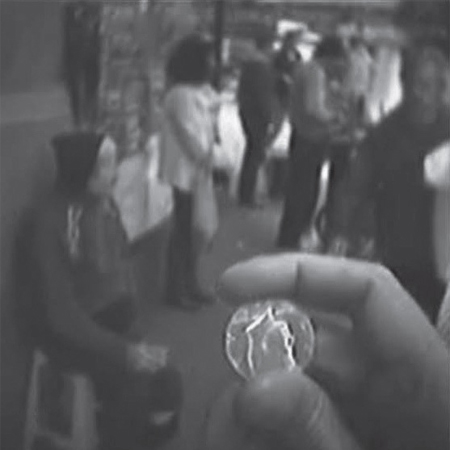 |
|
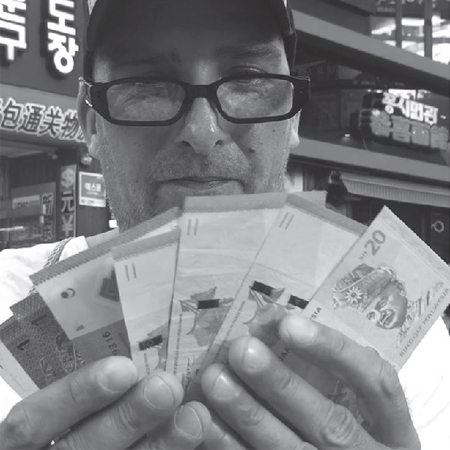 |
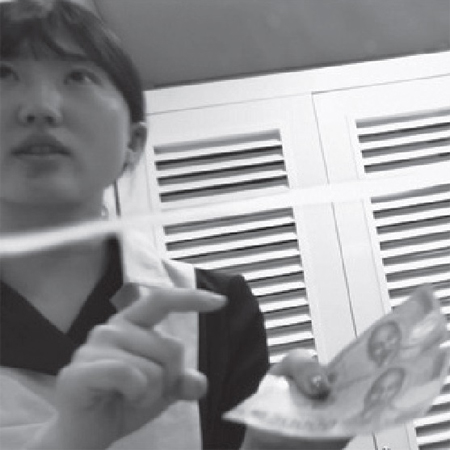 |
|
| CHANEGE, 12min 19sec, video installation, 2019 | ||
Q. What is your representative work/exhibition? And why do you think so?
A. In my latest solo exhibition entitled ’Bank of the Future Limited’ I focused on the society of “achievement-subjects” as it is defined in the book ‘The Burnout Society’ by philosopher Byung-Chul Han. I was interested in the symbolic places and characters representing today’s society that can’t be depicted anymore by the characteristic places of Michel Foucault’s disciplinary world of hospitals, madhouses, prisons, barracks and factories. It has been replaced by the society of shopping malls, fitness studios, airports, banks, etc. Because of their overflowing positivity, these symbolic environments are almost perfectly capable to exclude the possibility of any kind of revolt against the new regime of achievement society. Rather the increasingly threatening climate catastrophes are concluding the job worldwide instead of retired revolutionists with Molotov cocktails, having the only potential – however literally – to set our world on fire.
As one of the consequences of climate change is the migration of people that is envisaged in massive proportions in the future. Migrating middle class to economically more prosperous countries is substituted with even cheaper workforce from even poorer countries. Crises – either economic or ecologic – dissolve the order that regulates relationships among people.
For this project I used special transparent pigment – active only under ultraviolet light – to transform the design of banknotes and integrate ‘invisible’ scenes. I was inspired by one of Jorge Luis Borges’ allegoric stories. In the novel there are beings who are detained behind the mirror and one day they refuse to fulfil their punishment: the servile imitation of human gestures. In this project I was interested in the simultaneous depiction of the ideals of contemporary society and the broken reflection caused by the self-destructive chase for ultimate positivity.
 Exhibition view of Bank of the Future Limited, Schemnitz Gallery, Banská Stiavnica, Slovakia, 2019
Exhibition view of Bank of the Future Limited, Schemnitz Gallery, Banská Stiavnica, Slovakia, 2019
Q. 자신이 생각하는 대표 작업(또는 전시)은 무엇이고, 그 이유는 무엇인가?
A. 지난 나의 개인전 ‘미래 유한 은행(Bank of Future Limited)’에서는 재독 철학자 한병철이 그의 저서 <피로사회>에서 정의한 ‘성취주체(achievement-subjects)’의 사회에 초점을 맞추었다. 나는 오늘날의 세계를 대표하는 특정 장소와 사회에 관심이 있었다. 이는 미셸 푸코가 이야기 했던 병원, 정신병원, 감옥, 병영 그리고 공장과 같은 규율권력의 상징적인 장소로는 더 이상 묘사할 수 없는 것으로 푸코의 공간은 쇼핑몰, 피트니스 클럽, 공항, 은행 등의 사회로 대체되었다. 이는 넘쳐나는 가능성으로 인해 성취주의 사회의 새로운 정권에 대한 그 어떤 종류의 반란 가능성을 거의 완벽하게 배제할 수 있는 상징적인 환경이기 때문이다. 잠재적으로 유일한 (그러나 글자 그대로) 세계를 불태워 버릴 수 있는 화염병의 혁명이 물러난 대신, 오히려 점점 더 위태로워지는 기후 재앙이 전 세계를 종말로 이끌어 가고 있다. 기후 변화로 인해 예상되는 결과 중 하나는 앞으로 마주하게 될 심각한 인구 이주 문제이다. 중산층이 경제적으로 더 윤택한 국가로 이주하게 되면 더 가난한 나라에서 온 저렴한 인력이 그 자리를 대체하게 된다. 경제적인 위기나 생태적인 위기는 사람 사이의 관계를 통제하는 질서를 해체시킨다.
이 프로젝트에서 나는 자외선에만 반응하는 투명한 특수 안료를 사용하여 지폐 도안에 ‘보이지 않는’ 장면을 삽입했다. 이는 호르헤 루이스 보르헤스(Jorge Luis Borges, 아르헨티나의 소설가, 시인, 평론가)의 우화에서 영감을 받은 것이다. 보르헤스의 소설에서, 거울 뒤에 갇힌 존재들은 어느 날 노예처럼 인간의 몸짓을 따라해야 하는 형벌을 거부하기 시작한다. 여기서 나는 현대사회의 이상과 자기 파괴적인 추구로 인해 망가진 성찰을 동시에 묘사하는 것에 흥미를 느꼈다.
 |
 |
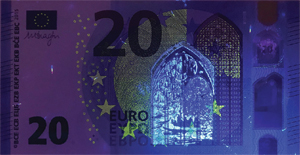 |
||||||||
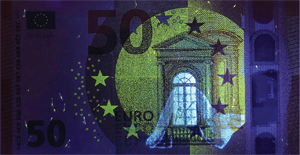 |
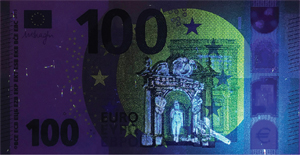 |
|||||||||
| BANK OF THE FUTURE LIMITED, transparent UV-active ink, stamps, banknotes, 2019 | ||||||||||
Q. What is the inspiration, motivation, moment of your work?
A. During both my gradual and post-gradual university studies I had the divine fortune to encounter inspiring personalities causing a 180-degree change in my artistic thinking. My curiosity and my rebellious nature led me towards uncharted waters of progressive artistic conceptions in the exciting period of freshly gained freedom after the fall of the communism in Eastern Europe. My interest shifted from painting towards video art, installation and performance art. I became interested in the tendencies of conceptual art and as a source of inspiration I read postmodern philosophy, sociology and art theory, watched avantgarde movies, listened to underground music and visited loads of galleries and museums of art. In my recent artistic practice I focus on the effect of cultural specificities on human values and contemporary human condition. My primary subject embraces social, economic, cultural, political issues and pointing out certain correlations between them.
Q. 작업의 영감, 계기, 에피소드에 관하여
A. 나는 대학과 대학원을 다니며, 나의 예술적 사고를 180도 변화시킬 만한 사람들을 만나는 행운을 얻게 되었다. 또한 나의 호기심과 반항적인 성격은 동유럽 공산주의가 몰락 이후 새롭게 주어진 자유의 시기에 나를 진보적인 예술 개념이라는 새로운 세계로 이끌어주었다. 나의 관심은 자연스럽게 회화에서 비디오 아트, 설치, 퍼포먼스 아트로 옮겨갔다. 개념 예술의 경향에 관심을 갖게 되었으며, 포스트모던 철학, 사회학 및 예술 이론 서적은 영감의 원천이 되었다. 또한 아방가르드 영화를 보고, 언더그라운드 음악을 들으며, 수많은 미술관과 갤러리를 방문했다. 나는 최근 작업을 통해 주로 문화적 다양성이 인간의 가치와 동시대 인간의 조건에 미치는 영향을 살펴보고 있다. 관련된 주요한 주제들은 사회, 경제, 문화, 정치적 문제를 아우르고 있으며, 나는 그 사이의 특정한 상관관계에 주목하고 있다.
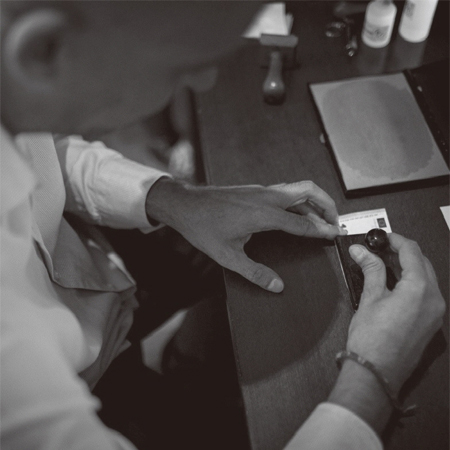 |
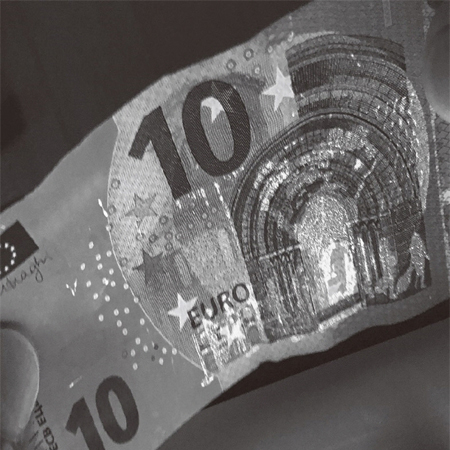 |
|
 |
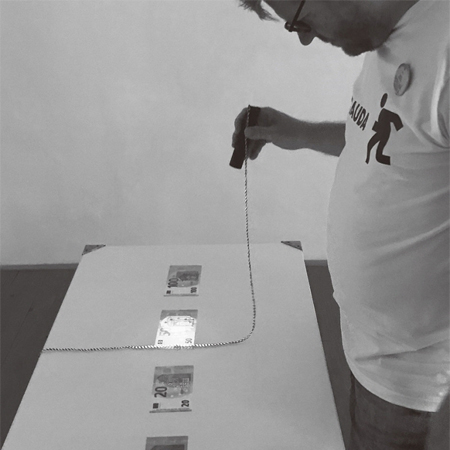 |
|
| BANK OF THE FUTURE LIMITED, transparent UV-active ink, stamps, banknotes, 2019 | ||
Q. How do you think about communication between art and spectators?
A. Ultimately my artistic practice is based on the opposition of intellectual property vs. the current regime of late capitalism. Let me be clear in saying that I do believe in art’s role in shaping of society and its potential to reach its audiences. Firstly, in the most basic level, it is evident that without art the world would be an infinite grey desert of bleakness. Secondly, most people agree that so called ‘high art’ is consumed only by a narrow elite. It might be so. But the role of art in today’s society is in a constant change. Messages of artist are passed over to audiences not only in the ‘white cube’ but also in public spaces but eventually it reaches broad masses on the internet, most typically on social media platforms. Artists of today have influence on before unknown audiences with issues targeted to their everyday life. I am convinced that every art is political by its nature.
Q. 예술, 그리고 관객과의 소통에 대하여
A. 궁극적으로 나의 예술적 실천은 지적 재산과 후기 자본주의 체제 간의 대립에 바탕을 두고 있다. 분명히 밝히자면, 나는 사회를 형성하는 예술의 역할과 관객에게 다가갈 수 있는 잠재력을 믿는다.
우선, 가장 기본적인 수준에서, 예술이 없다면 세상은 황량하고 암울한 회색빛 사막과 같을 것이다. 그 다음으로, 대부분의 사람들은 ‘순수 예술(high art)’이라는 것이 극소수의 엘리트 계층만 향유하는 것이라는 데에 동의한다. 그럴 것이라고 생각한다. 하지만 오늘날의 사회에서 예술의 역할은 끊임없이 변화하고 있다. 예술가의 메시지는 ‘화이트 큐브’ 안의 관람객에게만 전해지는 것이 아니라 공공장소에서의 관람객에게도 전달되며, 더 나아가 인터넷, 그중 가장 일반적으로 소셜 미디어 플랫폼을 통해 대중에게도 닿게 된다. 오늘날의 예술가는 알려지지 않은 관람객과 그들의 일상생활에 중점을 둔 문제에 영향을 끼치기도 한다. 그렇기 때문에 나는 모든 예술이 본질적으로 정치적일 수 밖에 없다고 확신한다.
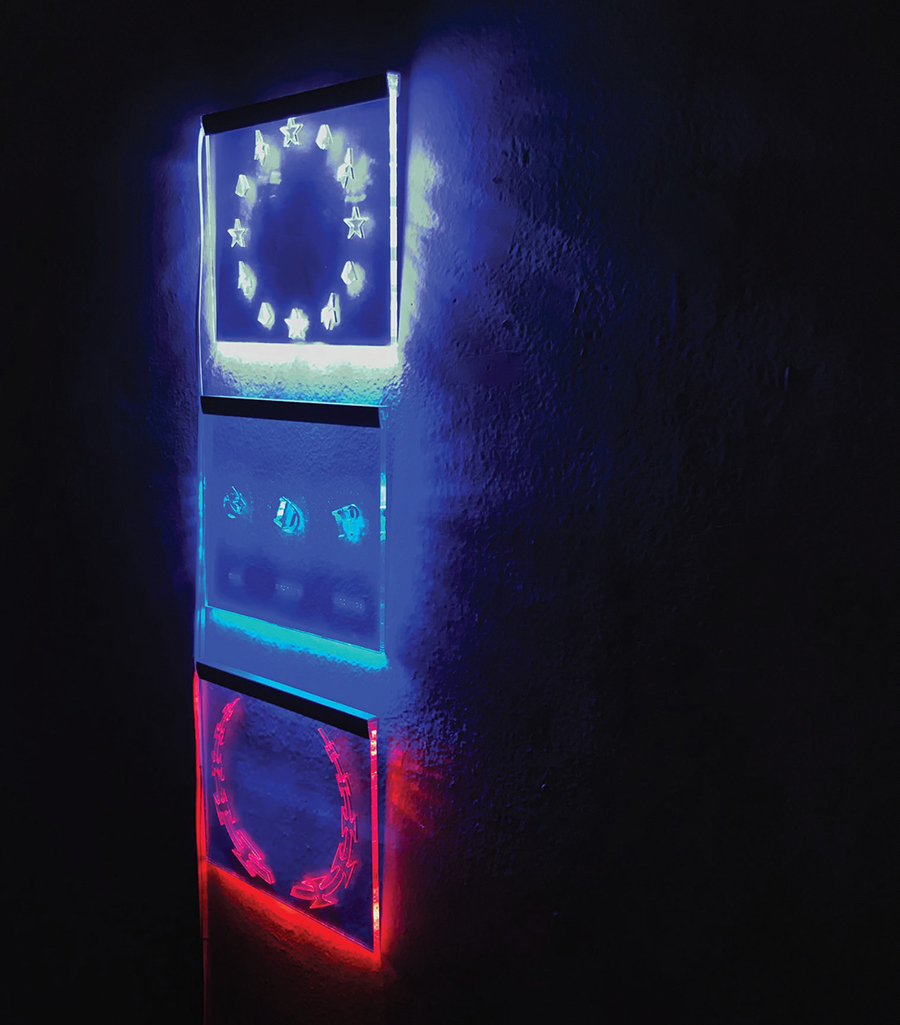 ÉGALITÉ, LIBERTÉ, FRATERNITÉ, 210×245mm (3 pieces), engraved plexiglass with LED lighting, 2016
ÉGALITÉ, LIBERTÉ, FRATERNITÉ, 210×245mm (3 pieces), engraved plexiglass with LED lighting, 2016
Q. Your wishes as an artist./ Your long-term plans./ Your goals and concerns, etc.
A. As an artist I wish to create more ‘open works’ as Umberto Eco referred to the topic in his book ‘The Open Work’. The book discusses the powerful concept of “openness”, the artist’s decision to leave arrangements of some constituents of a work to the public or to chance. I would like to improve my future works in that direction.
In one of my earlier performance art projects I decided to relax in a deck chair in the middle of the busy main square of a city. On a sign next to me the following text was readable: ‘An artist has the right to just lay around all day gazing at the sky’. I was trying to draw attention on the rights of individuals (not only artists) for a fulfilling and dignified life in a world that leaves less and less space for contemplation. One of my concerns aims to the cultural policies worldwide. I wish that the decision makers will have better understanding of the artist’s role in society – who creates cultural value in most cases free of charge – providing proper conditions for their creative functioning without ideological restrictions and predefined expectations.
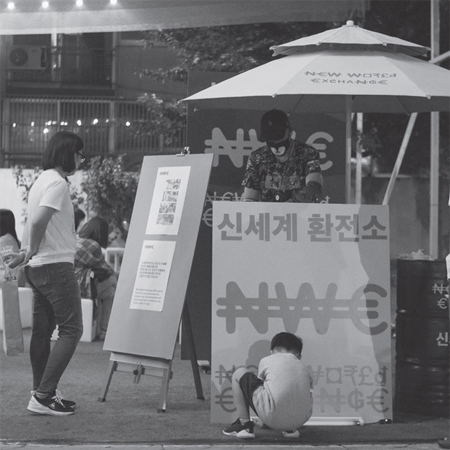 |
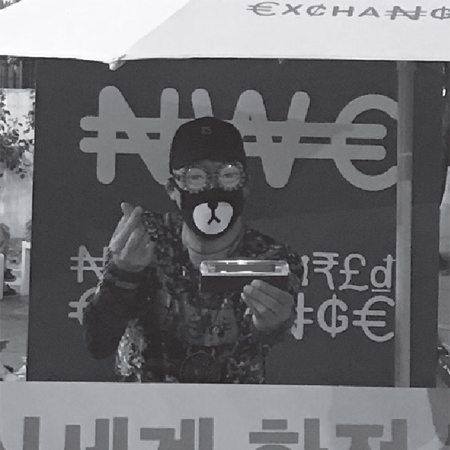 |
|
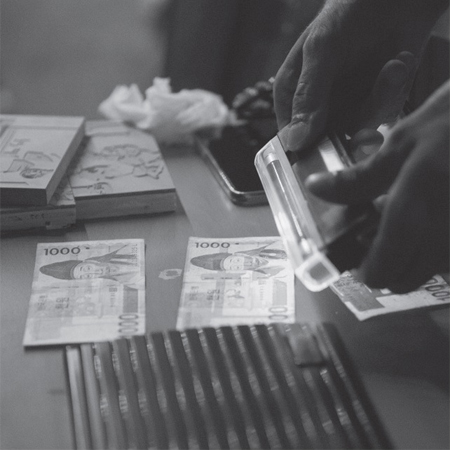 |
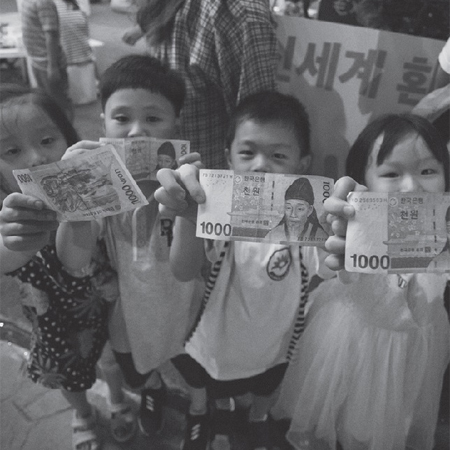 |
|
| NEW WORLD EXCHANGE, performance, Seoul Art Space Geumcheon, Seoul, 2018 | ||
Q. 앞으로의 작업 방향과 계획에 대하여
A. 가로서 나는 움베르토 에코가 그의 저서 <열린 예술작품(The Open Work)>에서 언급한 것처럼 더욱 ‘열린 작품’을 창조하고 싶다. 에코의 책은 ‘열림(openness)’이라는 강력한 개념에 대해 논의한다. 이는 작품의 일부 구성 요소를 대중에게 또는 우연히 공개하겠다는 예술가의 결정을 의미한다. 나는 앞으로의 작업을 이러한 방향으로 발전시켜 나가고자 한다.
나의 초창기 퍼포먼스 아트 프로젝트는 도시의 번잡한 광장 한가운데에 휴대용 의자를 놓고 거기서 휴식을 취하는 것이었다. 바로 옆에는 다음과 같은 텍스트를 배치했다. “예술가는 하늘을 바라보며 하루 종일 누워있을 권리가 있다.” 사색을 위한 공간이 점점 줄어들고 있는 세상에서 (예술가뿐만 아니라) 개인에게 성취감 있고 품위있는 삶을 살 권리가 있다는 것을 환기하고 싶었다. 나의 관심사 중 하나는 전세계의 문화 정책이다. 의사 결정자들이 (대부분 무료로 문화적 가치를 창출하는) 예술가의 사회적 역할을 더욱 잘 이해하기를 바라며, 이념적 제한이나 암묵적인 기대 없이 예술가가 창조적인 역할을 수행할 수 있는 적절한 환경을 만들어 주길 바란다.
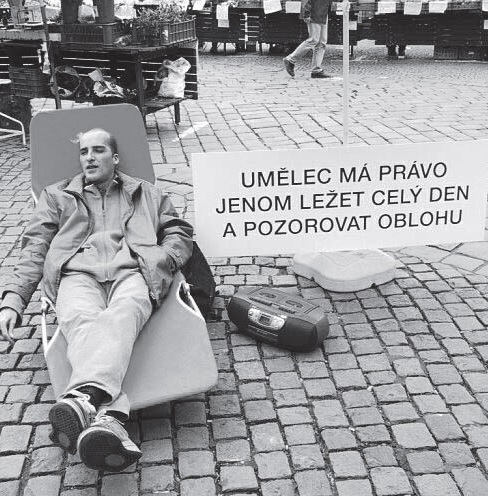 ARTIST HAS THE RIGHT TO JUST LAY ALL DAY AND WATCH THE SKY, performance, Czech, 2002
ARTIST HAS THE RIGHT TO JUST LAY ALL DAY AND WATCH THE SKY, performance, Czech, 2002